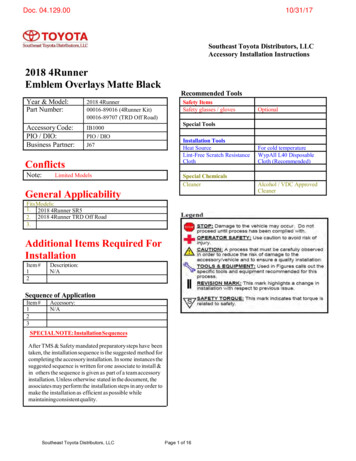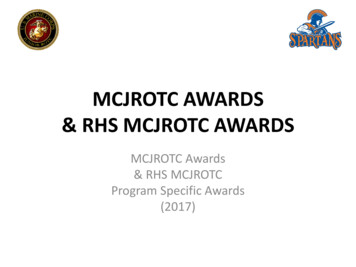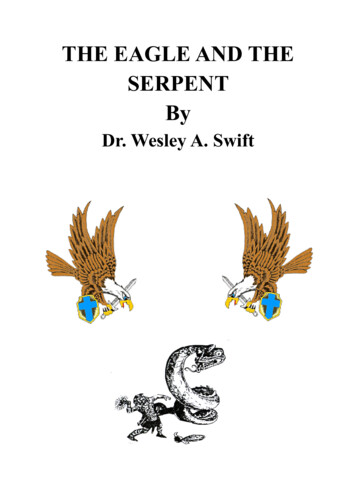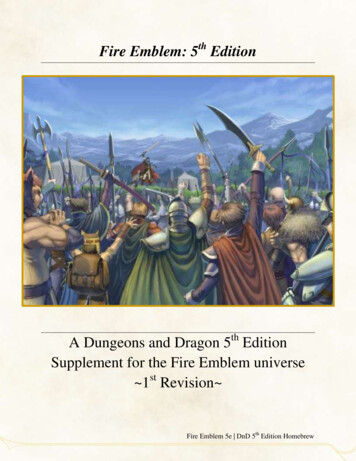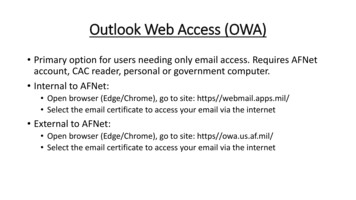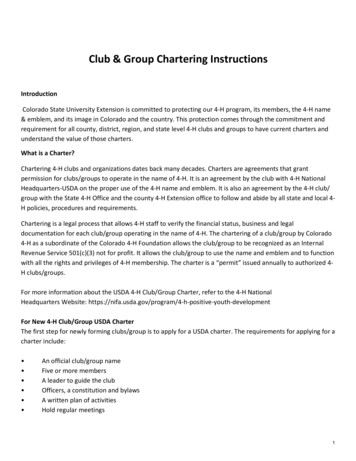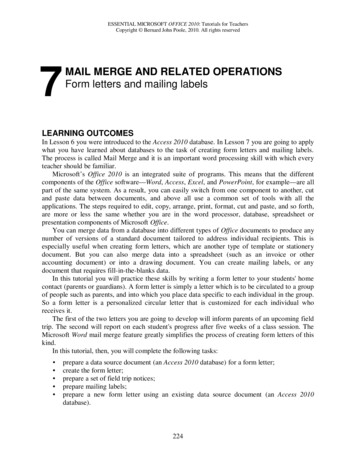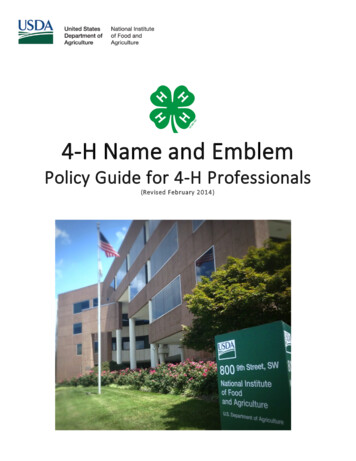
Transcription
4-H Name and EmblemPolicy Guide for 4-H Professionals(Revised February 2014)
Table of ContentsOverviewLegislative HistoryLegislative AuthoritySignificance of LegislationAuthorization ResponsibilitiesProviding AuthorizationRevoking AuthorizationReporting ViolationsApplying to be an Authorized UserAuthorization CriteriaBasicsProducts / H Name Guidelines4-H Emblem GuidelinesBasicsArtisticAnimationAppendixTitle 18 U.S.C. 707Authorization Approval Text (Example)Authorization Denial Text (Example)Authorization Revocation Text (Example)Violation of Use Text (Example)4-H 1819As Cooperative Extension workers, it is our responsibility to protect and promote use of the 4-H Nameand Emblem in order to reflect the educational goals and achievements of 4-H. This document isdesigned to assist you in carrying out this responsibility.Uni ted Sta tes Depa rtment of Agri cul ture, Na ti ona l Ins ti tute of Food a nd Agri cul ture, Di vi s i on of Youth & 4-H2
OverviewLegislative HistoryThe Smith-Lever Act of 1914 created the Cooperative Extension Service as a partnership betweenUSDA, the land-grant university system and local governments. This unique federal-state-localpartnership has functioned effectively for over 100 years.4-H youth development is an integral and essential part of the total Cooperative Extension System’seducational program. From the very beginning it was intended that the Cooperative Extension Servicewould provide for the teaching of youth. In 1912 the USDA administrators sent a letter to statesindicating that the regular emblem for all labels relating to youth clubs would be the four-leaf clover.The term 4-H Club was first used by USDA in 1918 and the four-leaf clover emblem was approved in1924. Thus, it became an official federal mark of the USDA, land-grant extension education for youthaudiences. In 1948, the 80th Congress legislated the 4-H Club name and emblem as the legal title andTitle 18 U.S.C. 707 was established to protect the 4-H Name and Emblem.The legal basis for 4-H work is set forth by the intent of the United States Congress as its membersdrafted the original 1914 Smith-Lever Cooperative Extension Act. The Act was amended to includethe words “and subjects relating thereto” in 1953. The amendment is explained in the report of theHouse Committee on Agriculture.The phrase “and subjects relating thereto” is added to the new language of theSmith-Lever Act to make certain that the new legislation will authorize all thoseextension activities, such as 4-H Club work, education in rural health andsanitation, and similar aspects of the manifold extension program heretoforeauthorized and now being carried on under existing law.The 1981 Agriculture and Food Act, Public Law 97-98, amended the National Agriculture Research,Extension, and Teaching Policy Act (NARETPA). NAREPTA includes 4-H in its official language whendescribing Extension activities. This act helps to clarify that youth development, including 4-H clubs, isa program area of concern to Congress and that it has been identified as a responsibility of the USDAin cooperative research, extension, and teaching efforts. 4-H is Extension’s education program foryouth.Legislative AuthorityThe 4-H Youth Development Program is defined as the education and outreach component of theCooperative Extension Services at land-grant institutions, and the U.S. Department of Agriculture(USDA). 4-H youth development programs are created and implemented by Cooperative ExtensionUni ted Sta tes Depa rtment of Agri cul ture, Na ti ona l Ins ti tute of Food a nd Agri cul ture, Di vi s i on of Youth & 4-H3
Services as a means for the land-grant institutions to carry out responsibilities under the Smith-LeverAct, 7 U.S. Code (USC) 341. The U.S. Congress has legislated responsibility for the propermanagement of the4-H Name and Emblem to the Secretary of Agriculture. The Secretary ofAgriculture has delegated that authority to 4-H National Headquarters in the Division of Youth and4-H, housed at USDA’s National Institute of Food and Agriculture (NIFA). The use of the 4-H Name andEmblem is defined through 7 Code of Federal Regulations (CFR) 8. Based on 7 CFR 8, USDA does notprovide authorization for use of the 4-H Name and/or Emblem outside the United States. The 4-HName and Emblem are a Federal Mark, protected by 18 USC 707, and intended only for use withinthe United States.Any questions as to the interpretation of the 7 CFR 8 are to be determined by USDA. Questionsregarding the use of the 4-H Name and Emblem may be directed to 4HNE@nifa.usda.gov. Furtherinformation about the use of the 4-H Name and Emblem can be found dev res emblem.html.Significance of LegislationIt is the legal responsibility of the Cooperative Extension Service and the USDA to insure theconsistent and correct use of the 4-H Name and Emblem by all levels of salaried and volunteerExtension staff, 4-H participants, and authorized non-Extension entities. Equally important is theresponsibility to communicate the significance of the 4-H Name and Emblem as a government ownedemblem that is protected by federal statute. By using the “18 U.S.C. 707” we are fulfilling our legalobligation to correctly inform the public of the federal protections and consequences of potentialmisuse.NOTE: The Cooperative Extension Service has the right to use the 4-H Name and Emblem for its ownpurposes in serving the educational needs and interests of the 4-H program. The authorizationinformation in this document relates to any non-Extension entity that an Extension office or USDAmight authorize to use the 4-H Name and Emblem.USDA is an equal opportunityemployer and service provider.Uni ted Sta tes Depa rtment of Agri cul ture, Na ti ona l Ins ti tute of Food a nd Agri cul ture, Di vi s i on of Youth & 4-H4
Authorization ResponsibilitiesProviding Authorization4-H National Headquarters at USDA is responsible forproviding authorization for any use of the4-H Name andEmblem that crosses state geographic borders. Per 7 CFR 8,authorization within a specific state is delegated to theCooperative Extension Service office at each land-grantinstitution. The Division of Youth and 4-H provides nationalstandards and support to the state and local 4-H officesresponsible for using and authorizing the 4-H Name and Emblem.4-HHeadquarters/ National usestate office /state useonlylocal office /local useonlyState 4-H offices (through their Extension office) are responsible for any 4-H Name and Emblem authorizations that cross local jurisdictionsbut are contained within the state. The term state can be interchanged with land-grant institution (1862, 1890, and 1994) and is inclusive ofU.S. Territories and the District of Columbia.Local 4-H offices (through delegation by their State 4-H office) are responsible for any 4-H Name and Emblem authorization limited to theirlocal area of jurisdiction. Local may refer to a county, parish, region, or district depending upon the structure of the 4-H program within anindividual state.Revoking AuthorizationThe authorizing entity retains the right to revoke 4-H Name and Emblem authorization at any timeprior to the expiration of the authorization. When the 4-H Name and Emblem is used onunauthorized goods or services, the public is misled into believing such items are affiliated with the4-H program. The Cooperative Extension Service and USDA have a legal and ethical responsibility toensure the “public trust” in the 4-H program.Reporting ViolationsAccompanying the authorization to grant authorization for use of the 4-H Name and Emblem is theresponsibility to see that the regulations are followed. Any alleged violation should be identified inwriting accompanied by adequate documentation to the authorizing entity, or the entity that wouldbe responsible for providing authorization if the violation related to unauthorized use. If afterreviewing the facts of the alleged violation it appears that there is cause, a written notification statingthe reasons for the appearance of the violations and a request to desist should be submitted to theperson or company in question.Uni ted Sta tes Depa rtment of Agri cul ture, Na ti ona l Ins ti tute of Food a nd Agri cul ture, Di vi s i on of Youth & 4-H5
If such notification does not result in satisfactory action, the matter should then be turned over to4-H National Headquarters who will work with the Office of General Counsel at USDA. Violations maybe reported to 4HNE@nifa.usda.gov.Applying to Become an Authorized UserCommercial vendors, private organizations, or other entities need to contact either the localCooperative Extension Service office or the state 4-H office to determine what steps they need totake to use the 4-H Name and Emblem. Anyone wishing to use the 4-H Name and Emblem in a waythat extends beyond an individual state 4-H program must seek authorization from 4-H NationalHeadquarters at USDA.To apply for authorization from 4-H National Headquarters, the entity seeking authorization shouldgo to the 4-H Name and Emblem Web page and click on the link to the Web-based /res/youthdev res emblem.html) When completing theapplication, be sure to specify how and why you plan to use the 4-H Name and Emblem and uploadthe documents or images as you plan to use them.Authorization CriteriaBasicsRegardless of whom the authorizing entity is, all federal regulations need to be followed. Thefollowing is a brief summary of the major sections in 7 CFR 8.Primary basis for all approvals include: Usage is for the educational and character building purposes of the 4-H Program The educational or informational uses are in the best interest of the 4-H Program Usage is consistent with the dignity of the 4-H Program Usage can be properly controlled by the Extension office Usage is for a specific time period Usage follows graphic use guidelinesAny use of the 4-H Name and Emblem is forbidden if it exploits the 4-H Program. The 4-H Name andEmblem cannot be used to imply endorsement of commercial firms, products, or services. Grantingauthorization to an individual or organization for a specific use does not signify exclusive use anddoes not prevent the granting similar authorization to another individual or organization for the sameor similar purpose.Uni ted Sta tes Depa rtment of Agri cul ture, Na ti ona l Ins ti tute of Food a nd Agri cul ture, Di vi s i on of Youth & 4-H6
Products and ServicesApproval for materials and merchandise should fall into one of the following categories:Educational /InformationalRecognitionCharacter Building /BelongingExamples:Examples:Examples: MeetingSupplies (notebooks, pens,etc.) Flags thingBagsMagnetsStickersJewelryAuthorization is required for the manufacturing, selling, and distribution of products or services usingthe 4-H Name and Emblem. This includes sales or re-sale of 4-H products and other paraphernalia byindividuals. A non-endorsement statement must accompany the use of the 4-H Name and Emblem onproducts and services.“No endorsement of this product or service is granted or implied by 4-H.”The following types of products will NOT receive authorizationto use the 4-H Name and Emblem.Note: This list is subject to revision.Animal FeedBeauty ProductsBeveragesFoodInsuranceLuxury ItemsPesticidesSolventsWeaponsUni ted Sta tes Depa rtment of Agri cul ture, Na ti ona l Ins ti tute of Food a nd Agri cul ture, Di vi s i on of Youth & 4-H7
MediaAuthorization is not required to use the 4-H Name and Emblem in exhibits, displays, etc. that aredesigned primarily to pay tribute to the 4-H Program. Authorization is not required to use the 4-HName and Emblem in print and non-print media such as newspapers and periodicals when such use isprimarily for educational or informational purposes. All 4-H Name and Emblem standards for properuse must still be followed.All other uses of the 4-H Name and Emblem in any media format require authorization and a nonendorsement statement must be used. Any use of the 4-H Name and Emblem in the production ofbooks, publications, films, audio-visual materials, websites and other technologies are subject toreview in both initial proposals and final drafts.Approval for PRINT and NON-PRINT media must meet the following criteria: The 4-H Name and Emblem must be clear, distinct, and set apart from anycommercial product message or reference when the media is part of or relates topromotional materials (example: fundraising activities, special events, etc.). The 4-H Name and Emblem cannot be integrated into or joined with othercompany logos/images to create a larger design. The materials cannot include any commercial product or service testimonials orpreferences by anyone associated with the 4-H program.Permission to use the 4-H Name and Emblem is not required when the 4-H Name and Emblem is usedto link to an official 4-H website in keeping with the policies and guidelines in this document. In thosesituations, the following disclaimer should be used:“No endorsement of this website is granted or implied by 4-H. This site containsadvertisement links to third party sites. 4-H is not responsible for the information foundthrough these links, nor does it endorse the sites or their content.”Fund RaisingIn seeking private support for 4-H programs, state and local extension officials must insure that thefunds are given and used in accordance with 7 CFR 8 and follow all 4-H Name and Emblem policies foruse. The development of private support that uses the 4-H Name and Emblem may be carried out forspecific educational purposes. Such activities, programs, and association of the 4-H Name andEmblem with products and services for such purposes must have the appropriate approval (local,Uni ted Sta tes Depa rtment of Agri cul ture, Na ti ona l Ins ti tute of Food a nd Agri cul ture, Di vi s i on of Youth & 4-H8
state, or national level). All fund development efforts must follow federal and state laws, and anyrelated policies of the land-grant institution connected with the effort.All profits must be used to further 4-H educational programs.In connection with 4-H fundraising purposes, the following disclaimer statement must be used onpromotional materials for products or services offered for sale:“No endorsement of the product or service by 4-H is implied or intended. Profit fromthis fundraiser will be used to support 4-H educational programs.”Fundraising activities using the 4-H Name and Emblem may be carried out for educational purposes,but these activities must have the approval of the appropriate authorizing entity. – Local activityrequires local approval; statewide activities require state approval; multi-state or national activitiesrequire 4-H National Headquarters approval in partnership with National 4-H Council. All moniesreceived from 4-H fundraising programs, except those necessary to pay reasonable expenses, mustbe used to support the 4-H educational program.Approval for Fundraising (sales or non-sales) should fall into one of the followingcategories and actions:Local or Stateconfer withthe state 4-H leaderMulti-state or Nationalconfer withNational 4-H Council National 4-H Council partners with 4-H National Headquarters to provide fundraising support. 4-H Name and Emblemauthorization must still be obtained from 4-H National Headquarters at USDA.The monies received and the expenses paid at auctions or similar fundraising sales events connectedto 4-H are subject to federal tax laws and Internal Revenue Service (IRS) regulations. Due to thecomplexity of IRS regulations, all 4-H members, organizations, and contributors involved in thesesales and events are strongly encouraged to seek guidance from their tax advisors regarding theirspecific accountability and situation.SponsorshipsDonor or sponsor identification and involvement with a 4-H contest, awards program, or event will beapproved only as a result of an agreement between the Cooperative Extension office receiving theUni ted Sta tes Depa rtment of Agri cul ture, Na ti ona l Ins ti tute of Food a nd Agri cul ture, Di vi s i on of Youth & 4-H9
support and the donor or sponsor. The agreement needs to define the type of award, purpose of theaward, criteria on which the award will be given, and/or the rules and regulations under which acontest or awards program shall be conducted. Donors of 4-H awards or sponsors of a 4-H contestcannot require the use of or refer to specific brand name products or services as criteria for an awardor in conducting a contest. Donors or sponsors should not be referred to as the “official” donor orsponsor of 4-H as it implies both endorsement and exclusivity.Any sponsor, donor, organization, individual, or group wishing to partner with the CooperativeExtension Service in sponsoring an award or contest shall receive authorization to use the 4-H Nameand Emblem from the appropriate extension office in their geographical area of responsibility prior toissuing any publicity or promotional materials related to the award or contest. A state organizationthat accepts donations and sponsorships using the 4-H Name and Emblem at the state level, shouldinform the donor that such authorization is for that state only and that multistate support requiresauthorization from NIFA’s Division of Youth and 4-H.In connection with sponsorships or donations, the following disclaimer statement is to be used:“ is a sponsor/donor of the [The name of a specific club, county, orstate may be inserted here to identify the 4-H program being supported.] 4-H YouthDevelopment program and has provided funding, goods, or services in support of 4-H.Acceptance of this sponsorship/donation does not imply endorsement by 4-H of anyfirm, product, or service.”PartnershipsThe 4-H Name and Emblem may be used in conjunction with the names, emblems, and word marks ofother organizations and programs when 4-H is a partner, co-author, or in some other officialrelationship that includes a written agreement. The nature of the relationship among theorganizations or programs should be clearly defined and include a non-endorsement statement. The4-H Emblem should be given prominence consistent with its role in the relationship.To avoid the appearance of endorsement of a program, product, or service, the 4-H Emblem may notbe incorporated into a larger design of a program, product, or service that is protected by trademark,service mark, copyright, or other similar laws. It is not acceptable to incorporate the 4-H Emblem intoany other organization’s logo or emblem. The 4-H Emblem should not be used or integrated into alarger design in such a manner that it becomes difficult to recognize or distinguish, or that is notconsistent with the graphic guidelines for use of the 4-H Emblem.The authority for determining the proper display and use of the 4-H Emblem rests with theauthorizing entity. The authorizing entity retains the right to revoke 4-H Name and Emblemauthorization at any time prior to the expiration of the authorization.Uni ted Sta tes Depa rtment of Agri cul ture, Na ti ona l Ins ti tute of Food a nd Agri cul ture, Di vi s i on of Youth & 4-H10
GuidelinesIntroduction:On May 17, 1985, the Secretary of Agriculture approved newly revised regulations governing the useand authorization of the 4-H Name and Emblem, as published in the Federal Register on August 2,1985. In addition, there was an amendment to these regulations published in the Federal Register onMarch 17, 1987. These regulations serve as USDA’s policy statement on the use of the 4-H Name andEmblem and are outlined on the preceding pages.To assist Cooperative Extension workers at all levels in interpreting these regulations, the followingset of guidelines was developed by a national committee. The committee included members of USDA,Cooperative Extension Service, and National 4-H Council. These guidelines were formally approved bythe Extension Committee on Organization and Policy in February 1986. The guidelines were reviewedand re-affirmed in September of 2000.4-H Name GuidelinesThe official 4-H Name includes 4-H, 4-H Youth Development, or 4-H Youth Development Program.When using the term “4-H” it must conform as follows: Numeral “4” separated from a capital “H” with a hyphen (not a dash, slash, or space). It is well documented in English usage, as well as in the most familiar style manuals, that youshould never begin a sentence with a numeral. To comply with this rule, you would need tobegin a sentence using “Four-H.” This language rule, however, is contrary to the regulationsset down for use of the 4-H Name and Emblem; if such a situation arises in writings, it is farbetter to re-word the sentence slightly to avoid the language rule. An exception to this wouldbe in writing news headlines where the 4-H name would be better served by using the familiarnumeral-hyphen-letter combination to provide instant recognition. Avoid separation of any of the elements of the 4-H Name at the end of sentences. This cansometimes be difficult because some software programs override user commands. Often,these overrides do not become visible until after printing or posting to a Web page: carefulscrutiny of text after trial printing or posting is advised. Do not use the 4-H Emblem in place of the word “4-H” in a title or text.Uni ted Sta tes Depa rtment of Agri cul ture, Na ti ona l Ins ti tute of Food a nd Agri cul ture, Di vi s i on of Youth & 4-H11
4-H Emblem GuidelinesBasicsThe official 4-H Emblem is a four-leaf clover with a letter “H” in each leaf and the stem turned to theright. The Emblem may be two-dimensional (flat) or three dimensional (with shadows that showdepth and perspective). Authorized users of the 4-H Emblem must ensure the following: They have obtained the official 4-H Emblem and are using it in its entirety. They do not “flip” the image to create a framed look. The stem on the 4-H Emblem mustpoint to the right as you look at the image. They are familiar with resizing graphics through the software application being used, and donot distort or warp the dimensions of the Emblem. The 4-H Emblem is never used to imply endorsement. They follow the graphic use guidelines outlined in this document, or for questions orclarifications, contact 4HNE@nifa.usda.gov.Use the whole Emblem. The 4-H Emblem should always appear in its entirety—meaning it shouldalways appear as a whole and complete image.Do not remove any leaves. The leaves cannot be removed or have another image superimposedover the top of any of the leaves. Other images should be moved and appear completelyseparate from the 4-H Emblem. This also means you should not “cut off” a leaf by running it offthe edge of the paper in print media or other designs.Appropriate UseInappropriate UseUni ted Sta tes Depa rtment of Agri cul ture, Na ti ona l Ins ti tute of Food a nd Agri cul ture, Di vi s i on of Youth & 4-H12
Do not place text or other images over or on top of the 4-H Emblem. The 4-H Emblem shouldnot appear screened or watermarked under words or graphics. No photo, drawing, symbol, word,or other figure or object may be placed on or obscure the 4-H Emblem.Appropriate UseInappropriate UseKeep it upright. The 4-H Emblem should not be rotated or turned on its side. There are someexceptions, such as on fabric where the emblem is scattered randomly across the fabric or inother random designs. Any exceptions must be approved by the authorizing entity.Appropriate UseInappropriate UseDistortion and Proportion. The appearance, shape, and proportion of the 4-H Emblem shouldnever be distorted to fit in an imprint space. Do not make the 4-H Emblem longer, taller, wider,angled, or squarer. Do not alter the shape in any way. The overall size of the 4-H Emblem may bechanged, but the proportions must remain intact.Appropriate UseInappropriate UseUni ted Sta tes Depa rtment of Agri cul ture, Na ti ona l Ins ti tute of Food a nd Agri cul ture, Di vi s i on of Youth & 4-H13
Color. The 4-H Emblem should never be screened, shaded, gradated, or appear in a multicolored hue. Graphic Designers: The official color is 100% PMS 347 green.The clover can be green, white, black, or metallic gold. Below are the official guidelines for each colorclover:The “H’s” on the green clover can be white, black, or metallic gold.The H’s on the black clover should be white.The H's on the white clover can be black or green.The H’s on the metallic gold clover can be white, black, or metallic gold (whenembossed).The one exception to the above descriptions of the color of the H’s is when only one-color printing isbeing used. With one-color printing the H’s can be reversed out to the color of the paper (or medium)on which the emblem is printed.One-color printing requires either PMS 347 green or black. For commercial applications, the "18U.S.C. 707" notice should be the same color as the clover leaves. Black or white are the onlyacceptable alternatives to green for one-color printing.Two-color printing - Only PMS 347 green may be used for the leaves and “18 U.S.C. 707” notice.Four-color process (full color printing) - In four-color process printing, PMS colors are approximatedusing a particular combination of the standard four-color process printing inks. The four-colorprocess percentages required to match 4-H’s PMS 347 green are: cyan 100%, magenta 0%, yellow90%, and black 0%. There is no PMS equivalent to PMS 873.Uni ted Sta tes Depa rtment of Agri cul ture, Na ti ona l Ins ti tute of Food a nd Agri cul ture, Di vi s i on of Youth & 4-H14
Video and Computer Screen Colors (Electronic Media) - The colors transmitted by electronic mediaare created using precise combinations of RGB (red, green, blue). The correct RGB values for the 4-Hgreen are: R 51, G 153, B 102. No other colors are acceptable.For exceptions to the guidance provided regarding color, please contact the appropriate authorizingentity.ArtisticThe 4-H Emblem can be used for materials such as jewelry or fine art and may be made of metal (e.g.copper, bronze, gold, or silver), glass, leather, or wood without conflicting with the colorspecifications for the 4-H Emblem. Ceramic, plaster, paper, fabric, or any materials that are coloredor painted must comply with the color specifications and all other guidelines.Use of the emblem on fabric, whether painted, screen printed, embroidered, appliquéd, or someother technique, must accurately represent the 4-H Emblem in authorized colors and adhere to allother use guidelines.The 4-H Emblem is not open to reinterpretation or reconfiguration, regardless of its intended use,including the development of materials such as jewelry, sculpture, signage, crafts, or other fine art.AnimationAnimation of the 4-H Name and Emblem is allowable provided that the animation is in keeping withthe guidelines in this document, and that at the end point of the animation (where the animated loopstops or begins to repeat if an ongoing loop), the 4-H Emblem appears in a manner that meets allguidelines for its use.Animation may also show the 4-H Emblem on a waving flag, on a float that is partially hidden bycrowds watching a parade, being placed in a box or behind a curtain, twirling as it “dances”,“separating” as it forms the doors opening to welcome you to the 4-H Program, be partially hidden asit forms the backdrop for a youth speaking about 4-H, slowly come into focus or formation as the 4-HEmblem from an amorphous or other background, or completing itself as the clover leaves are addedone by one to form the 4-H Emblem and each H is explained. In each of these cases, the 4-H Emblemmay be temporarily blocked, in whole or in part, or have its shape altered. The end point of theanimation must still comply with the guidelines.Uni ted Sta tes Depa rtment of Agri cul ture, Na ti ona l Ins ti tute of Food a nd Agri cul ture, Di vi s i on of Youth & 4-H15
AppendixTitle 18 U.S.C. 707 (June 25, 1948)Public Law 772 – 80th CongressChapter 645-2d Session(H.R. 3190)Whoever, with intent to defraud, wears or displays the sign or emblem of the 4-H clubs, consisting ofa green four-leaf clover with stem, and the letter H in white or gold on each leaflet, or any insignia incolorable imitation thereof, for the purpose of inducing the belief that he is a member of, associatedwith, or an agent or representative for the 4-H clubs; or Whoever, whether an individual, partnership,corporation or association, other than the 4-H clubs and those duly authorized by them, therepresentatives of the United States Department of Agriculture, the land grant colleges, and personsauthorized by the Secretary of Agriculture, uses, within the United States, such emblem or any sign,insignia, or symbol in colorable imitation thereof, or the words "4-H Club" or "4-H Clubs" or anycombination of these or other words or characters in colorable imitation thereof - Shall be finedunder this title or imprisoned not more than six months, or both. This section shall not make unlawfulthe use of any such emblem, sign, insignia or words which was lawful on the date of enactment ofthis title.Authorization Approval Text (Example)This is to advise you that the Authorizing Entity has extended authorization to Company to usethe 4-H Name and/or Emblem on Specific Items for a period of Time from the date of this letter.Conditions of this authorization are based on the information submitted by you on the application forauthorization received by our office.We reserve the right to review, inspect or withdraw authorization at any time for violations in the useof the 4-H Name and/or Emblem or variances to the information submitted in the application. Alluses of the 4-H Name and/or Emblem must serve the educational needs and inter
designed to assist you in carrying out this responsibility. . The term 4-H Club was first used by USDA in 1918 an-leaf clover emblem was d the four approvedin 1924. Thus, it became official an federal mark of the USDA, landgrant extension education for youth - . 4HNE@nifa.usda.gov. Applying to Become an Authorized User . Commercial vendors .
